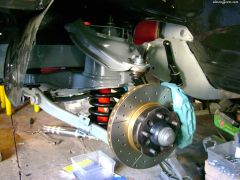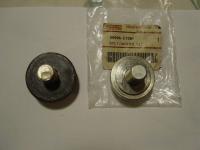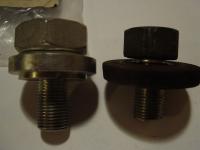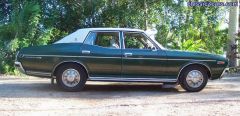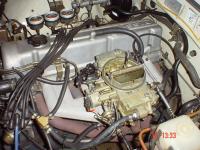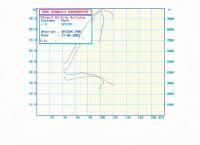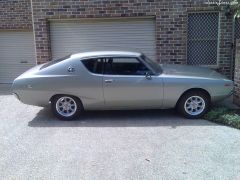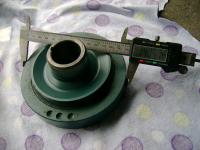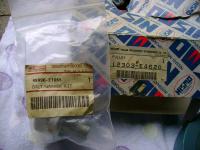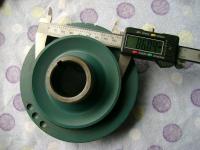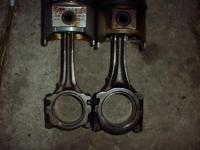Everything posted by ozconnection
-
Datsun 240C coupe
-
3 into 2 MSA header
We've been here before haven't we? All engines, regardless of their state of tune will benefit (to some degree) from an improved exhaust system over the stock system, even the L24! An excellent book on the subject is: Scientific Design of Exhaust and Intake Systems Third Edition Philip H. Smith John C. Morrison 2002. First written in 1962, and before the L series existed, there were experiments galore made by these boys on what works and what doesn't. Exhaust system pulsing, like that in the intake system, can be used to enhance the running performance of an engine if the exhaust is designed to take advantage of this phenomenon. Grab a copy from your library and read up fellas.
-
which carb is for me
I've used a range of Holley four barrels on my L28 for years. :stupid: They're ok but to truly get them running right for the engine for which they were never designed to be on, takes quite a bit of tweaking. I'm currently getting a #4548 Holley 450 cfm four barrel worked over by a professional carb rebuilder to suit my L28 after an extensive dyno session identified a number of areas that needed reworking on my #1848 465 four barrel. Basically, the fuel curve was all wrong. The boosters and emulsion tubes are being replaced/modified on the #4548 to suit my combination. You can't generally do this at home unless you've got an intimate knowledge of Holley's and the tools necessary to change the boosters. So what you get when you buy a Holley four barrel is a carb where some but not all the fuel characteristics can be modified by the backyard guy and achieve roughly 80-90 percent success. Then there is the HP series of Holley's. The #80507 is a four barrel 390 cfm double pumper but even this performance carb doesn't have an adjustable metering block(s) but the boosters are doglegs which are better than the standard jobbies. So what is one to do? It would seem to me that for the Z guys out there, a properly worked over set of SU's are available over the counter. That's really hard to beat for convenience my friend. Good luck.
-
harmonic damper from MSA
Check out these!! I think you can see the differences for yourself. I bought the setup because I wanted to make sure my harmonic balancer stays on. I'm going to be using crankfire ignition with my next engine and that's kinda essential, not to mention the issues with the crank and the 'welding' of the balancer to the crank snout if things are allowed to get loose down there. Money well spent, in my opinion. Cheers.
-
The 260C after a good clean
-
Engine cooling questions.
I don't mind you using my photo for this topic, just say who ya got it from. Cheers:paranoid:
-
HP gains going from 2 SUs to 3 OERs
Looks more like 11.3 to my eyes. Good run, well done Tom.
-
HP gains going from 2 SUs to 3 OERs
Post the dyno sheets for us to all have a look at mate. Cheers
-
Vacuum advance with triple carbs
There are two ways of connecting your vacuum advance mechanism up. One is ported and the other is full manifold vacuum. With full manifold vacuum, the amount of advance is proportional to the amount of vacuum it sees. So, doddling around with a closed throttle creates a high vaccum in the manifold, which pulls hard on the advance diaphragm on the dizzy advancing the timing. The engine should be able to tollerate this because of the decrease in dynamic volumetric efficiency with a closed throttle. Now, as the throttle is opened, more mixture is allowed into the engine, VE goes up and advance decreases because the vacuum drops...get it? Sure the mechanical advance still works, adding timing up to a point around 3500rpm (this varies with engine to engine). So at wide open throttle, vacuum is low and over 3.5K rpm the mechanical advance is all in and the vacuum advance mechanism contributes nothing to the advance curve. At a very light load, most engines can tollerate advance of up to 45 degrees BTDC without problems. The higher the octane of the fuel used, the better this works. High octane fuel burns relatively slowly. Race cars that have 11:1 or higher compression often have the luxury of running very high octane gasoline or other additives which helps to maintain their advance curves. For the street however, octane is lower, compression should be a little lower and cams are often very big, which 'bleeds' the engine of its low rpm efficiency due to valve overlap. Often the dizzy is regraphed for such a setup, making the springs lighter so the advance comes in quicker than stock. A street type engine is more tolerant to an advanced ignition at low rpm due to the way in which it was constructed. Cheers.
-
Vacuum advance with triple carbs
My understanding of triple whatevers is that they are the gun performance setup for track work on engines like ours. For an engine that rarely sees less than 4k rpm, then vacuum advance is a waste of time. When the car is used as a street car or a dual purpose machine, then the boundaries become less clear IMO. Perform your own experiment. Do the work needed to run a vacuum line to your distributor. Try both setups for yourself...on the street. Tell us which one works the best. ie response economy etc. On the track, have the advance disconnected and plugged. Tell us how you get on.
-
Clifford intake
Is your Holley a spreadbore? The primaries on a 650 spreadbore holley are quite small and offer good throttle response compared to, say, a 600 square bore Holley on a Clifford manifold. I do like the reverse idle setup on a 650 spreadbore Holley. I found that it's easier to tune the idle and off idle characteristics than a conventional metering block and as a result, fuel economy on a light throttle was very good. Don't give up too easily on your 650. If you don't already have a 390, save your cash and buy some jets and power valves and go ''play with it" Cheers!
-
Cam question
I decided to attach a dyno sheet of a run I made several years ago, comparing the stock cam I had in the engine with a modified, aftermarket grind from Ivan Tighe 462C spec. No other changes were made other than to instal the camshaft correctly. A/F ratio's were tested and deemed to be acceptable and a solid basis for comparison. Yes, the rpm ceiling was higher, up to 7200rpm, but what about the rest of the power and torque bands? I may have been 'put off' by this venture but I have the dyno sheet to prove the worth of 'changing the camshaft'. Would you recommend a bigger cam to someone if you had results that looked like this??? http://tighecams.com.au/profiles3/nissanlseries.htm
-
Cam question
I personally have nothing against using a big cam in an engine if that is what is required for the situation. Race, rally, drag etc. You're obviously happy with your choice of cam and thats fine. In this situation, ekaphoto wanted suggestions about a combination that would work well on the street, suggesting that low speed driving was a priority and fuel efficiency was important. Suggesting a stage 4 cam to someone who is asking for our opinions is a little ambitious IMO. I think we'll never agree on this since our ideas on what is appropriate are so fundamentally different. What we have provided for this guy are some ideas on what he can go out and try on his ride and perhaps which direction to take. Good luck ekaphoto, let us know how you get on with your project. Jon, I have posted dyno graphs on this web site for you all to see. Read what I have written about them and you might begin to understand the reasons why I have what I have under my hood. It's the most appropriate combination for MY situation. Cheers.
-
Cam question
I saw this question in Hybridz but I thought I might add my bit here too. Be wary of the statement..."Lopey idle".:paranoid: That to me suggests low speed engine inefficiency due to camshaft overlap and intake mixture contamination from residual exhaust gasses. Usually it means a faster idle speed and richer idle mixtures just to keep the thing running. At high idle speeds with weak distributor springs or one removed to alter the distributor advance curve, the advance is kicking in, creating a hunting idle behaviour that is a PITA to sort through. At the point in the rpm range where maximum engine torque exists, maximum fuel efficiency is very close as well. Having said this, a camshaft like the one suggested to you moves the torque band up the rpm scale so you're left with less low speed torque. You can't have everything!!! Take from here and give to there is what will most commonly happen with those camshafts. The biggest problem I see with bigger cams is the amount of overlap that gets included along with big valve lift figures and durations. I asked this question in Hybridz a few days ago and asked what would a dedicated performance TURBO grind be like to drive? From my own investigating, it has merit. Healthy valve lift...yes. Acceptable intake and exhaust durations...yes. Minimal valve overlap....YES. Loss of low speed torque...Not as much as a similar cam used for normally aspirated use. More power..I can't see why not, but probably not as much as the N/A cam of approximately the same size...but who cares? Keep the bottom end smooth and responsive with more kick up top...I'm convinced I'm going to have to try this one for myself. I'll test my car again soon on the dyno for a new baseline. Then I will go and change over to a Schneider turbo cam I already have and re-dyno the thing. (I already have some dyno graphs posted here and you can see how much torque a stock cam can muster). If all goes to plan, then there should be an increase in the top end without loosing too much down low. Any thoughts??? Cheers.
-
Engine Drops RPM when Idling?
Sounds like you've got it sorted Mark. That's more like the RPM drop I would have expected, 200 rpm sounded a little bit too much IMO. All the best! Mark.
-
Engine Drops RPM when Idling?
From a slightly different angle, check your idle mixtures. I use an innovate air/fuel ratio thingy and whilst the engine will idle with a reasonably wide range of mixture strengths, the added load of an alternator doing more work or the release of the clutch pedal will load up the engine and cause the drop in rpm you're experiencing. If your mixtures were right without the load, they probably won't be after it. Check your mixtures when the load is on the engine. Adjust accordingly. I tune my car in gear (automatic) so I can sit all day at the lights with a mixture strength I know works and helps to stabilize my idle rpms. As a ball park figure, I run 13.0:1 with a warm engine, in drive and at 750 rpm (850 in neutral...thats only 100 rpm drop through an automatic trans!!). I also make slight carburettor adjustments for the anticipated weather, usually twice a year. Cheers mate.
-
Timing questions
Get a good timing light,if you don't already have one. I recently bought one off ebay and within 10 minutes after using it for the first time, i had pulled off my 280zx distributor and was replacing it with another 'good' spare I had. With a good timing light, like the equus (I think thats how you spell it) you can checK your initial advance, your total advance and at what revs this all happens. Greatest tool I bought since my Innovate wide band Air/Fuel ratio meter thingy.! Money well spent. I will let others suggest timing starting points for you, their engines are a little closer to your specs. ie webers etc. Good luck.
-
White smoke at high RPM
Its not auto is it?
-
new mags and mostly together
-
harmonic balancer
I did notice that the fit onto my LD28 crank was a little too tight. I didn't measure the internal/external dimensions of the two, but it seems that there is work to be done to make it work. So too the pulley groove. Why did you have to repaint the timing marks...what was wrong with them? Was there a manufacturing issue with the marks...and crank bore? Seems odd that Nissan would produce something that needs so much 'corrective' work. Cheers.
-
harmonic balancer
-
L28 turbo, how n wat to do
There were two different spec L20AET engines. One has heavy duty internals, like the rest of the L Series family, the other one had internals similar to the L24E (Maxima in the US, Skyline in Oz), small rods and journals. If you look on the engine block and head, those numbers may be able to tell me which one you have. Many years ago I bought an L20 turbo (two actually) and grafted the bits onto my L28. I used the turbo cam from the L20 and the intake and exhaust manifolds too. The turbo gives great boost to the L28 at very low engine speeds so it turns the thing into a torque monster. Don't try and rev it because the turbo is too small and you run the risk of overspeeding and killing it. You'll need an intercooler too if your goung to run with anything more than factory boost. Other goodies include the head bolts, oil pump and cam cover and factory water to oil cooler (if fitted). Do yourself a favour and get a turbo that won't strangle your top end. VL Commodore turbochargers are just about perfect for the L28! Cheers!:classic:
-
Crankshaft Casting Numbers
Get off the computer and go into your shed and check for yourself mate!!! Don't slag off on others because you're too lazy.
-
harmonic balancer
I don't know if the BMW unit is fluid filled. Ask SWR or the guy who quoted you one if they are. Sounds like you want the best balancer for your high revving motor. I guess its hard to blame a balancer for a grenaded bottom end. How would you prove that it was the balancers fault?? I'd personally go for a balancer that was built for my motor in the first place although there may be absolutely nothing wrong with using the modified BMW unit. I would just check with the company selling the other balancer if it's the best one they have available for the L Series and is it suitable for racing? The smaller pulley diameter on the balancer is a bonus too, keeping rpms down on your water pump (ie keeping the pump running in its sweet spot for optimal pump efficiency) and reducing thrown belts. I threw in a couple of pictures of what the Nismo balancer looks like. Needs a special bolt and washer setup...the bolt is longer and the washer registers with the face of the balancer. Note the small width of the pulley groove. Good luck...Cheers:)
-
harmonic balancer
I know that Stuart Wilkins in Sydney makes harmonic balancers for L series engines using BMW parts. Go and ask him for a price. Then consider the cost of the balancer on ebay and the cost of postage. You'll soon find out which way to go. It looks very similar to the genuine Nissan motorsport one that used to be available. The only hassle with that old one was that it ran a very thin belt groove so that a stock fan belt wouldn't fit. I would, at a guess, think that the one for sale on ebay has had that issue corrected so that a normal fan belt will fit. There are quite a few companies out there that sell special balancers for L series engines from simple lightweight machined alloy things to great big heavy things like the BMW conversion balancer. I guess it has something to do with how hard you're gonna rev the thing to how well the bottom end is balanced. What does everyone else think? Cheers





